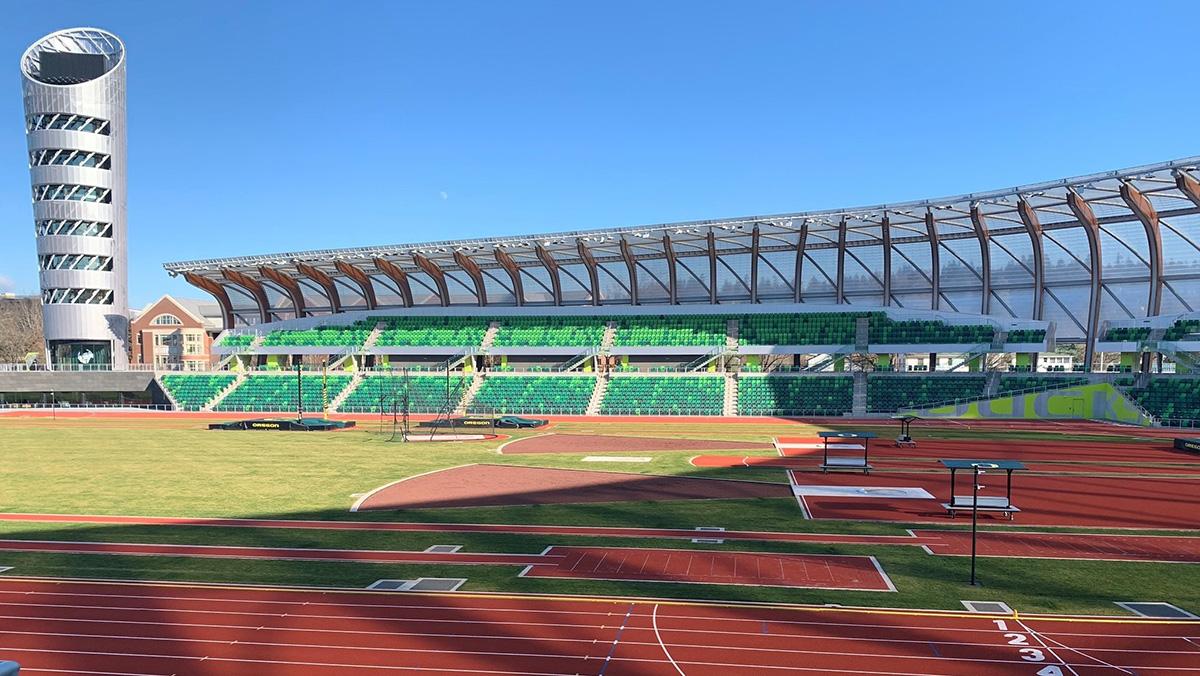
by Ola Adeniji, PhD Candidate, Department of Human Physiology
Historic Hayward Field has been home to record-breaking performances set by athletes at many levels. Located on the University of Oregon campus in Eugene, Hayward Field has hosted over two dozen elite and collegiate championship track and field meets. The highly touted 2021 NCAA Track and Field Championships, followed by the rescheduled 2020 US Olympic Track and Field Trials, were both held in June of last year in the newly renovated stadium. This summer brought athletes and track fans across the globe to participate in and witness the 2022 Oregon World Championships, the first held on US soil.
Championship meets of this caliber have served as signature platforms for the sport of track and field outside of the Olympic Games. While the Olympic Trials and World Championships feature elite athlete performances, the NCAA Championships solely feature collegiate athlete performances. The track and field community—athletes, coaches, media, team staff, spectators, scientists—have watched championship meets fascinated by how athletes of collegiate and elite stature produce performance marks and times of such high levels. Questions may arise around rankings, but many concern performance. How does an athlete run so fast? How does an athlete jump or throw an object so far? What allows an athlete to endure competition over several days?
Most sports fans equate performance of an athlete with being talented, competently coached, well-conditioned, disciplined in their training and preparation, and perhaps the possession of a high mental capacity. Although those factors can play a role in performance, scientists over the years have also studied athlete movement to interpret and monitor performance. Thus, biomechanics of sports is the most fitting field for studying track and field movements under the umbrella of human physiology.
Sport biomechanics has been described as movement and the associated mechanics of that sport. Historically, the field has been driven by sports scientists tailoring study types—sports-related injuries and performance—toward a non-Hispanic male population. An investment in the vision and evolution of track and field by World Athletics, the international track and field governing body, facilitated 20 years’ worth of biomechanic study projects conducted during major championship competitions at the elite level. As these projects provided analyses on elite performances, the international track and field community came to appreciate them as ways to better understand events competed in and meet results achieved. Analyses at the college level would also be welcomed for those who have come to expect and witness great performances at the NCAA Track and Field Championships.
The framework of my dissertation project was built on and inspired by the research work conducted by World Athletics. With a similar vision, this project supports continued advancement in the sport at the college level, where action toward athlete development, coaching knowledge, and performance improvement are made. Past sports performance research in the US has primarily focused on data collected in lab-controlled settings with select research interventions. Although these studies have added to the discussion of performance within sports science, there is room for other narratives. Therefore, this project begins with an analysis of collegiate female sprint and jump participants at the NCAA Championships to better understand performance in competition.
In preparation for footage data collection, project components and logistics were discussed at great length with world-renowned sports scientists affiliated with World Athletics. This team of experts had recently yielded over 50 event-specific track and field reports from the 2017 London Outdoor and 2018 Birmingham Indoor World Championships combined. My project’s primary data collection was completed during the 2021 spring and summer academic quarters. With funding support from organizations such as CSWS, I traveled overseas to the United Kingdom to meet in person with World Athletics expert sports scientists for project post-processing and analysis technique training.
Preliminary review of footage taken with high-speed cameras showed desired areas were captured as intended. Going forward, digital tracking will be used during post-processing. Select body-segment models have also been chosen for footage analysis for the purposes of gathering data to describe the motions being performed and the cause of those motions by each athlete. The quantitative values coming from these analyses relate to kinematic (i.e. velocity) and kinetic (i.e. force) characteristics reached during performance. While kinematic values focus on describing a motion an athlete makes, kinetic values account for the “causes” of the motion an athlete exhibits in competition. In other words, one can think of motion as representing the effect of movement, and force representing the cause of that movement. These components of sports biomechanics are key to understanding the factors that can determine and influence performance in sports.
There is an opportunity to add to the library of literature written on not just sport performance, but also on high-level women performing on the college stage. It is my hope that this work will help to inform and educate the track and field community, and all who wish to engage in myriad ways. I am confident all the pieces have been put in place to complete this magnitude of work as I look to be impactful in my capacity as a coach and sports scientist. Much appreciation to CSWS for their support of women in the sciences.
—Ola Adeniji received a 2021–22 Graduate Student Research Grant from CSWS.

